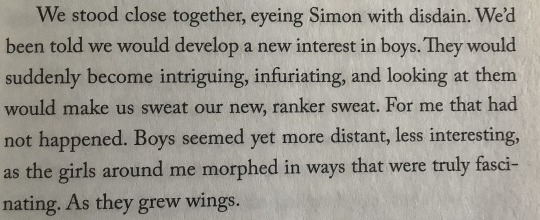#the temporal heterotopia of it. or whatever.
Text

liddy, the first to fly from lesser known monsters of the twenty-first century, kim fu
#kim fu im in love with u#omg that rhymed#this is the queerest story in the collection to me#and one of them is a free use lesbian sex scene#so#yeah yeah i had a queer (strange/gay) obsession with a girl for five years of primary school whatever#point is. there is Something about the becoming of an eleven year old girl#and the becoming of the eleven year old girls around you#the temporal heterotopia of it. or whatever.#words
0 notes
Text
Division, Unity, and Passing Through - Foucault and Doyle
In his essay on space and heterotopias, Michel Foucault writes on the nineteenth century crisis in history. Its accumulation of pastness had become overwhelming and cyclical, resulting in a prioritization in space and segmentation. When we create spatial segments, we can also create divisions in understanding to whatever chosen areas of study with relative similarity. Therefore, Foucault is more interested in the meta study of space as a concept in Western experience in what seems to be an attempt to interlock seemingly unlike spatial histories with a technology of form. In understanding space as a technology of form, the changing proximity, arrangements, and relations of coded elements both within and outside a space might give a different and productive way of understanding the continual unfolding of historical relations.
In Snowpiercer, for instance, we might say this dystopia acts as the site of the other. For Foucault, utopias act as a sort of mirror held up to our society, a placeless place of desired self-recognition. It’s a place that acts as a perfect vision of what we’d like to see in it and what it could be. But from the standpoint of the mirror, we also discover our absence. The dystopia could be seen in a similar light, but one of dysmorphia. Like the misrecognition of dysmorphia, science fiction often mobilizes extrapolation-- taking certain pieces that exist within our society now and magnifying them into an imagined potential future if those issues go unchecked. As such, Snowpiercer takes class divisions and turns them into physical train cars with locked gates, where the governing bodies define who and what might “logically” pass through. Codes are inscribed on the body in the form of dress, hairstyles, uniforms, and each suggest a relation to each train car’s space as one of belonging and mobility or that of intrusion that must be expelled or exterminated.
Adding to the relational and technological elements of Foucault’s heterotopias, Briohny Doyle gives us a more specific space to consider: the post-apocalyptic space. For Doyle, the apocalypse takes on the temporality of “the middest” or what Vivian Sobchack might consider “lounge time” in looking back on the historic shift that gave way to film noir in their day. Both of these are periods of waiting and, like Sobchack, Doyle notices that such apocalyptic depictions may seem stagnant between historical modes of meaning-making but, like noir’s “lounge time,” apocalyptic tales can also be attributed to anxieties about the shift between specific moments of history. Likewise, the newer trend towards post-apocalyptic narratives, or the lull after the big event, charts Foucault’s nineteenth century feeling of accumulating non-history, with big events that never seem to bring about any real change; they just move into a new aesthetic version of the old-- Doyle’s “catastrophe without revelation.”
As such, post-apocalyptic narratives revolve around shifting relations and identity to best chart the codes of the present within the new aesthetic of the post-apocalyptic space. This can be seen in the proliferation of “between” characters like cyborgs or hybrid human creatures, but this can also be seen plainly in evolving status and who and what kinds of people and actions move that status forward. The big reveal at the end of Snowpiercer that the conductor had been sending the messages of revolution all along, for instance, charts a very specific relation to our protagonist’s heroic status, as one that was secretly permitted and not earned-- even though we as audience members received the same affective quality of this sort of “American Dream” quality we get with other heroes throughout the whole movie. This relation is an important part of the let down. However, this is clearly not to say the aesthetic space is unimportant, although I’m running out of blog space. Ghosts and ruins often proliferate within the post-apocalyptic space, charting a future that is not devoid of its past but distinctly haunted by it and, in this movie, one that goes around and around and around as each new character is permitted to start a “new” society for Earth.
0 notes